Pawn Diamonds for Cash
For years, diamonds have been among the most valued precious natural stones to exist. We buy diamonds for cash exchange! There’s simply no denying the brilliance, beauty, or rarity of these stones-diamonds. This is why many people will pay great sums for these beauties. Like the saying goes — a diamond really is forever.Whether you’re looking to sell loose diamonds, pawn an old engagement ring, or to make custom diamond jewelry, we want to ensure everyone buying, selling, or pawning diamonds is fully educated on the process. There are several characteristics to focus on, which can be a bit overwhelming. However, if you have the right mindset and want to spend money in an efficient way to ensure you have a higher resale value down the line, sell because of an emergency, or pawn or borrow against your diamond, you must purchase the diamond with the correct attribute mix.
We service the following areas throughout Massachusetts:
- Boston
- South Shore
- Quincy
- Dorchester
- Milton
- Braintree
- Hingham
- Cohasset
- Weymouth
- Randolph
- Holbrook
- Rockland
- Abington
- Hanover
- Marshfield
- Pembroke
- Hanson
- Whitman
- Mattapan
- Lower Mills
- Plymouth County
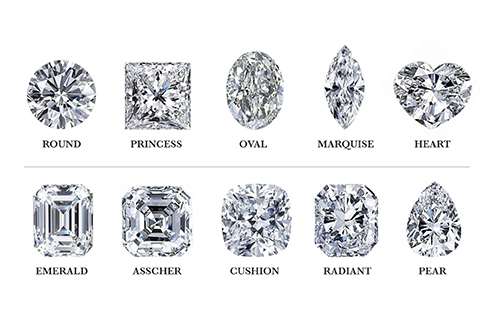
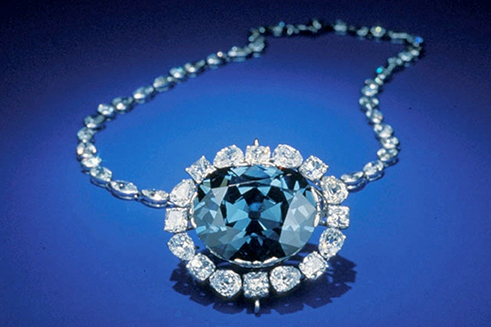
The Diamond Cash Exchange: An Introduction
What makes a diamond so special? Is it the look, the rarity, the association with commitment and love? Or what about the status, or the way they’re formed in nature? Suffice to say, there are many reasons to love diamonds. There are many factors that make diamonds valuable.
There are key terms that help you through your diamond education when looking to make a custom engagement ring, buy a pair of diamond earrings, or pawn borrow on your diamond piece. BlueNile and their private equity partnership has completely transformed the diamond buying experience and impacted lots of local jewelers. Nowadays, consumers can price shop based on online information.
While a great business, going solely off certificates isn’t the best idea. Instead, you should buy diamonds based on the stone. GIA certificates, or diamond reports, are issued by an accredited independent gemological lab. Including the carat weight and measurements, a certificate factors in grades for the diamond’s cut, color, and clarity. These certificates are vital to pricing diamonds. However, you’re buying the stone — not the certificate! With a certificate, the in-person visual is not accounted for. There are several factors to consider when looking at diamonds, but philosophy, preference, and long-term objective need consideration.
The world’s fascination with diamonds has been going on for centuries. But what makes diamonds so special? Some may like the look. Others may value the rarity. Certain consumers may value their association with commitment and love. Some may even like the status that comes with them, or perhaps the way in which they are formed in nature. There are so many reasons to love diamonds and so many factors that influence people’s love for these stones. There are also many factors that make diamonds valuable, especially today.
Before you start diving into the specifics of what makes a diamond a diamond and what makes these stones unique, there are a few different key terms that can help you through your diamond education if you’re looking to custom make an engagement ring, buy diamond earrings, or pawn borrow on your diamond. BlueNile and their private equity partnership has transformed the diamond buying experience and has affected a lot of local jewelers. Now, more than ever, consumers are able to price shop based on the information provided online. Although a great business, buying diamonds solely based on the provided certificates is not a good idea. You should buy diamonds based on the stone. GIA Certificates, which are also called diamond reports, are issued by an accredited independent gemological laboratory. In addition to the diamond’s carat weight and measurements, a certificate includes grades for the diamond’s cut, color, and clarity. These certificates are very vital to diamond pricing; however, you want to buy the stone, not the certificate! When you see a diamond in person, you are actually experiencing the life of the stone and how the facets attract or don’t attract light. There is nothing quite like seeing how a diamond looks up close and personal. With a certificate, the in-person visual is totally discounted. For example, when a stone is so-called “milky” the GIA certificate will not report this. One could liken the issue of “milkiness” to an ice cube. You may ask yourself, how clear is the ice cube with respect to its composition? Are there streaks or cloudiness? There are many factors to consider when looking at diamonds, but diamond-philosophy, your loved one’s preferences, and long term objectives should be considered when making a purchase.
Here are parts of the diamond that every person buying or selling diamonds should know:
- Brilliance – The brightness that is created when you look at the stone or the sparkle created by a combination of the white light reflections from the surface and the inside polished portion of the diamond.
- Certified Diamond – A diamond that has undergone quality analysis by a gemological laboratory and has a lab report or certificate with it. Typically, diamonds are certified by the Gemological Institute of America (GIA), AGSL (American Gem Society Laboratory), EGL (European Gemological Laboratory), IGI (International Grading Laboratory), Diamond Grading Report, Report Numbers, or a GIA Diamond Grading Report.
- Crown – The top part of the diamond above the girdle, but below the flat top of the diamond. It goes around the outside of the stone.
- Cutlet – A small facet located at the bottom of a finished diamond.
- Facet – A flat, polished surface on a finished diamond.
- Fire – Flashes of color inside the polished diamond upon visual inspection.
- Girdle – A very narrow section of a finished diamond that creates a boundary between the crown and the pavilion.
- Pavilion – The lower part of a faceted diamond, located below the girdle.
- Scintillation – When you move a diamond and see flashes of light.
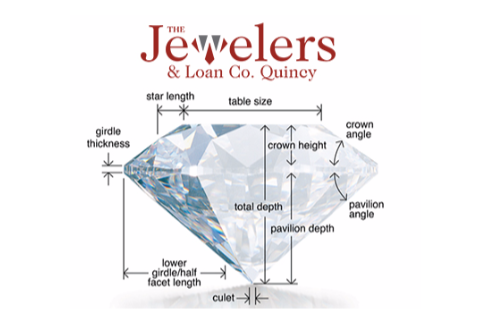
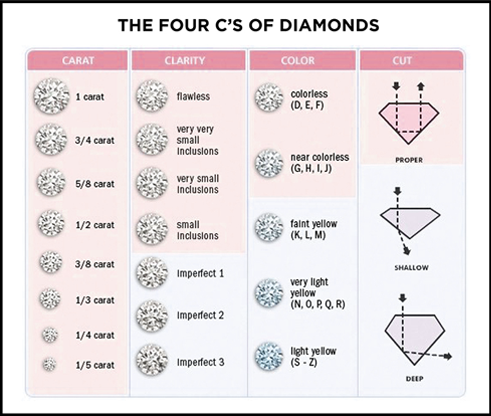
The Four C’s of Diamonds
- Carat
- Cut
- Color
- Clarity
Most diamond buyers and sellers only walk you through what these are instead of actually educating you on what they mean and how you can use them to your advantage. We value our customers and want to help them make the best decision possible when it comes to their diamond transaction.
Carat Weight or Diamond Size
Carat weight is perhaps the most substantial indicator of value in diamonds. In most cases, the bigger the diamond, the more expensive it is. However, just because a diamond has a high carat weight, it doesn’t necessarily mean that it is costly.
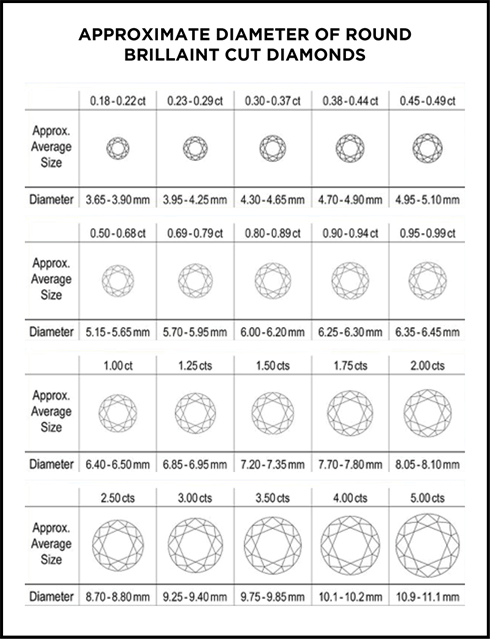
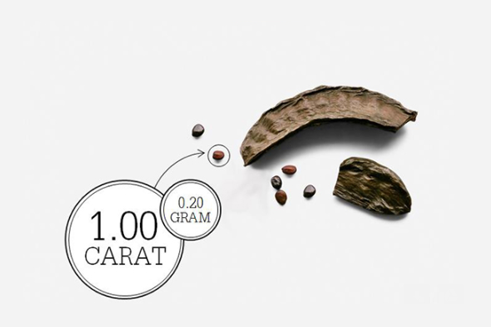
What is a carat?
1 carat is only 1/5 of a gram and 1/142 of an ounce. In diamond terms, a carat or even a percentage of a carat is a pretty big deal. Pay attention to the size of the stones rather than going off of Carat Total Weight.
Carat weight is typically expressed in decimals. 1.00 ct. is a one-carat diamond, a 1.51 ct. is a carat-and-a-half. Diamonds that are less than a carat are expressed in points such as “that diamond weighs 78 points” or is a “78 pointer.” This means that the diamond is 0.78 cats.
If a diamond is right under a carat, or 0.98 ct., it may be referred to as a “light carat.”
Specialty Stones
When it comes to assessing the value of a diamond, you may not always come across a piece that just has one large stone in it. The stone may have small diamonds around it or have colored gems stones surrounding them.Carat Total Weight of smaller stones of less than .20 ct. each has a significantly smaller resale cash value than one single diamond.
The following is what you need to know about rings like this.
Small Stones
Jewelry set with tiny, faceted diamonds are called melee diamonds. Melee diamonds typically weigh less than 15 points in size. They still have value, but aren’t going to have as much as a large stone with the same weight.
Gemstones
While gemstones like rubies and sapphires don’t all hold the same value, one would calculate the total gem weight of the piece. This is how many carats of diamonds and colored stones are featured in a single item. When determining the value of the piece for sale or trade-in, you’ll likely need to determine the weight of each gemstone type and the diamonds. You should determine the resale value of the diamonds, the market value of the diamond, and the cash value of the diamond based on today’s prices for diamonds.
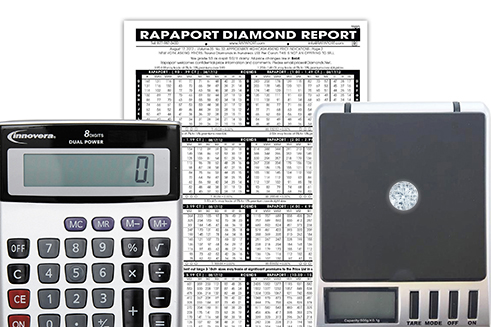
How to Compute the Cost of Your Diamond
Once you have a diamond that you are ready to buy, sell or trade in, pawn, or borrow, you must know how to compute the value. Higher quality or clarity means higher prices. The lower the quality or clarity, the more affordable the diamond becomes.
Cost = Carat Weight x Per-Carat Price
For example, if you are selling diamonds that are valued at $3,0000 per carat and you have a 1.96 ct. diamond on your hands, you would be looking at a value of $5,880. If you want to determine the per-carat price of a piece, you would perform the following equation:
Total Price = Per-Carat Price x Carat Weight
For example, if you have a 3.12 diamond on your hands that is worth $12,540, this is how you would do the calculation:
$12,540 / 3.12 ct. = $4,019.23 (per-carat)
Frequently Asked Questions
Our advice for buying diamonds is as follows:
Buy certified diamonds by The Gemological Institute of America Diamond Grading Laboratory. Aim for quality, which means SI2 Clarity & G or better Color.
Refrain from buying smaller diamonds sold as Carat Total Weight. You will get more value by spending the money on a single quality diamond a half carat or larger.
Better Quality = Higher Price = Higher Resale Value
Lower Quality = Lower Price = Lower Resale Value
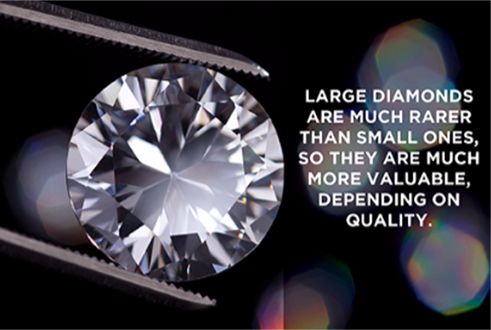
So, the Bigger the Diamond, the More Expensive It Is?
Not necessarily. When it comes to buying and selling diamonds, aim for quality. We have many customers that think the bigger the carat weight, the more the diamond must be worth.
Yes, a 2-ct. diamond is going to cost more than a 1 ct. diamond if all of the other factors are the same. But, if the color and clarity don’t match up, then the smaller diamond could actually be worth more. It is all about all of the diamond characteristics coming into play together.
Diamond Dimensions
- Our buyers use a diamond scale for our customers to make sure they get the most accurate reading possible on their loose diamonds and diamond jewelry pieces. We determine the size by using a millimeter gauge for estimating the carat weight of the diamond. Although, precise weight is only one part of the bigger picture. It is important to know the accurate dimensions of any diamond, too. It can not only help you have a better understanding of the diamond you are buying or selling, but it can help you if you need to identify a stone or choose the proper size or type of mounting for a stone you are putting into a diamond engagement ring.Knowing the dimensions of a diamond will also help you determine how big the diamond will look when it is set.
- Depth – Measured from the top to the bottom, or the table to the cutlet. Depth percentage is one of the most vital criteria for light to travel optimally through the diamond.
- Diameter – Taken in round diamonds, this is the measurement from one girdle edge to the opposite girdle edge, straight through the center. Regardless of how well cut a diamond may be, no round diamond is perfectly round. The diameter measurement allows jewelers to determine the prongs they can utilize to mount it.
- Length and Width – Used when you are getting the dimensions of fancy shape diamonds, such as an oval or princess cut diamond.
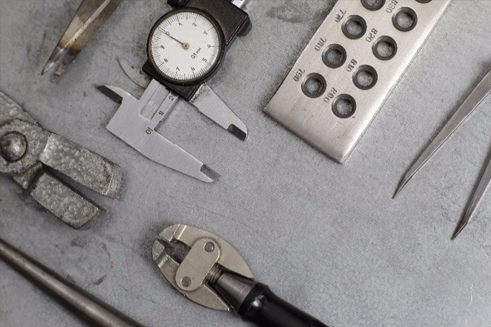
Diamond Tools Used to Measure Diamond Dimensions
There are a few different tools that can be used to measure dimensions. The magnifying glass or whistle-shaped object customers notice around a jewelers neck is a loupe. One of the most common, and one you may see at our jewelry store in Quincy, is the millimeter gauge. This instrument has jaws on it to hold the diamond in place to take the most accurate measurements across a variety of spots along with the diamond.
There are also hole gauges or templates that correspond to various diamond girdle measurements. There are also scanners or optical measuring devices that can help give a dimensional measurement on a loose diamond.
Cut
Determining the cut of a diamond can be complex. There are so many elements that go into the cut of a diamond that impacts everything from its clarity to its color. The cut of a diamond determines the interaction between the stone itself and the light around it. This impacts the diamond’s appearance. Diamonds with factors with what dealers call “triplex”, meaning excellent cut, polish, and symmetry trade a premium for those characteristics.
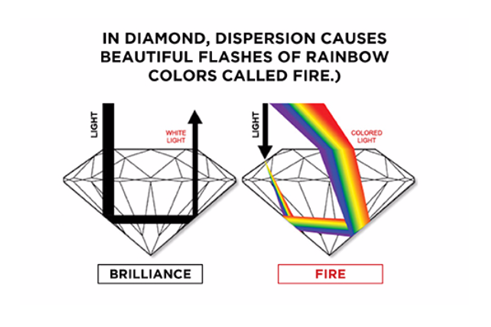
Cut and Lighting
Why do certain diamonds have so much sparkle and life, while others look flat and milky? We’ve seen it before – when you enter an environment with the perfect lighting and your diamond just can’t help but sparkle.
When a light ray hits a diamond, it either enters into the stone, or it reflects off its surface. When it reflects off the surface, the diamond gives off that beautiful white light.
The proportions of the cut of your diamond will impact how the light bounces off of the diamond, and ultimately, its sparkle factor. A well-cut diamond is one with good proportions, symmetry, and polish, and it’s important to understand how these three elements work together to help make your diamond shine.
Proportions, Polish and Symmetry of Diamond Cutting
Well-cut diamonds have good proportions, but they should also be well-polished and have a certain amount of symmetry. There are several elements to a well-cut diamond, including:
-
- The outline of the girdle. The girdle is where the diamond sits on its prongs and it should not impact the look of the diamond if it is cut properly. If the girdle isn’t cut to proportion, it will impact how much the stone shines.
- The table size determines how much light enters and leaves the diamond. You want a stone with medium tables that let just enough light in to allow the stone to sparkle, but not so much that it overwhelms other components.
- The crown angle. The higher the crown, the greater the crown angle. Diamonds with shallower crowns are typically more fragile yet more brilliant, while those with higher crowns tend to be the opposite.
- The pavilion depth is the distance between the girdle plane and the cutlet. If the distance is too deep, it can make the center of the stone appear dark.
- The length-to-width ratio is important in fancy shaped diamonds and the overall ratio can help with the look of the diamond
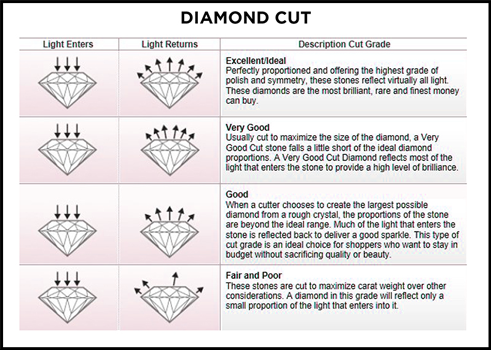
Diamond Polish
A diamond’s polish is essential for maximum brilliance, fire, and scintillation. The polish is meant to describe the overall condition of the facet surfaces of the finished diamond. Rating a diamond’s polish involves distinct categories, including poor, fair, good, very good, and excellent. Each rating takes into account the amount of lines, marks, and other blemishes present on the stone.
Diamond Symmetry
The third element of a cut of a diamond is the symmetry. Diamonds are examined for their symmetry under 10x magnifiers. While we may consider most diamonds to be perfectly round or symmetrical, there is no such thing, as there are always variations. Akin to the diamond’s polish ratings, symmetry ratings include the same categories and take into account any extra or misshapen facets, proportions, and alignment.
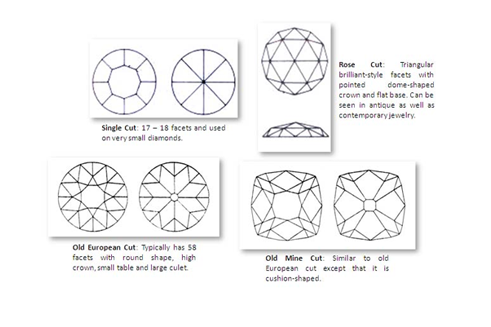
Diamond Cut Types
For most buying or selling diamonds, it is the type of cut that means the most. Here’s a breakdown:
Brilliant — Cut with triangular or kite-shaped facets that begin at center and radiate outward.
Standard Round Brilliant — The most popular diamond cut with either 57-58 facets.
Single — Typically used on small diamonds with 17 or 18 facets.
Fancy — Any shape other than round, including princess, cushion, pear, marqui, heart-shaped, radiant, and oval cut diamonds.
Step — Long, narrow facets cut in rows parallel to the diamond’s girdle. Typically, there are three rows.
Baguette — A small four-sided step cut either rectangular, square, or tapered.
Mixed — Brilliant and step facets are featured.
Branded — Manufacturers will sometimes develop and name their own cuts.
Color
Most thik diamonds are colorless. A master GIA color grading scale is useful in grading an accurate color for diamond. Most don’t realize slight color differences at first, but upon placing two diamonds with different colors side by side, it can be easy to tell the difference. Diamonds are generally less desirable when the stone is dark or gray-looking.
True colorless diamonds are extremely rare and valuable. Most don’t have these colorless diamonds, though. They appear on the D-to-Z scale, which depicts the diamond’s hue.
This scale is broken into five sections.
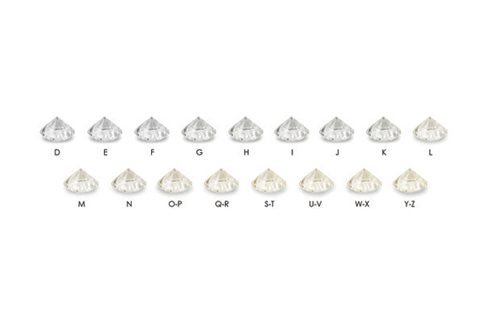
Colorless Diamonds (D-F)
The rarest colorless diamond will be rated “D.” However, any diamond with a D, E, or F rating is considered colorless.
Near Colorless (G-J)
These appear colorless to the naked eye but are still very valuable. When mounted, G, H and I diamonds actually look colorless face-up: one of the biggest reasons why most labs don’t rate diamonds while they are mounted.
Faint (K-M)
Here, you’ll start to see some light yellow hues. Most will be able to see a faint coloration when they look closely, but many times, if you mount them in the proper setting such as yellow or rose gold, you can barely tell the difference.
Very Light (N-R)
These are going to look yellow. In some environments, it may not be as noticeable as others.
Light (S-Z)
Diamonds with light color grading will look dark yellow or brown and be far less valuable, regardless of size and cut.
Fancy Colored Diamonds
When you want to buy diamonds, the less color you have in a diamond, the better. However, there is an exception — fancy colored diamonds. These diamonds are actually supposed to be colored. A notable one of these types of diamonds is the Hope Diamond, which is blue, or pink or fancy canary yellow diamonds.
The list below gives the possible rankings. The first three grades apply to every colored stone except for yellow.
- Faint
- Very light
- Light
- Fancy light
- Fancy
- Fancy intense
- Fancy vivid
- Fancy dark
- Fancy deep
Also, there exist treated diamonds that have color added to them to create a hue. These are much less valuable than naturally colored diamonds. We advise avoiding treated diamonds, lasered diamonds, filled diamonds, color enhanced diamonds, or other types in those categories.
Clarity
“Perfect diamonds”, no matter the price tag, are almost impossible to find. Nearly every diamond you’ll come across has some sort of imperfection — this is where clarity factors in.
What does Diamond Clarity Mean?
Clarity is a collective term used to describe the different inclusions and blemishes inside the diamond.
- Inclusion is a characteristic that is enclosed inside a polished diamond that extends through the surface of the stone. The imperfection is “included” inside the stone.
- A blemish is confined to the surface of a polished gemstone. It can be a nick or imperfection that occurs on the outside of the stone.
Typically, an inclusion has more of an impact on the beauty and value of a stone than a blemish. The location of the inclusion is a factor as well. An inclusion located in the center table is not desirable, as imperfections such as black carbon can be visually seen with the naked eye.
There are other imperfections that you should be aware of, as well:
-
- Bearding: A hair-like line developed along the stone’s girdle.This typically occurs during the cutting process.
- Cavity: When a diamond has a deep opening in its surface. Cavities usually happen during polishing when the polisher touches a natural internal inclusion and causes it to dislodge from the diamond.
- Chip: A small shallow blemish on the surface of the diamond, usually near the girdle. It is typically the type of blemish that comes about from accidental knocks.
- Cloud: Clouds are actually clusters or crystals or pinpoints that form extremely close together to create a “clouded” look.
- Crystal: This happens when an actual mineral crystal is contained within a diamond. This can happen when diamonds are forming over time. They can be colorless, black, red or green. Feather: A small crack within the diamond. Sometimes, when light catches on even a small feather, it becomes visible to the naked eye.
- Training: An imperfection from irregular crystal growth. Internal graining can cause the stone to appear hazy or milky.
- Needle: Typically long and thin and are usually white or transparent. They are most visible at 10x magnification.
- Pinpoints: Very small black or white crystals embedded inside the diamond. They look like small dots and individual pinpoints may not be visible unless viewed under 10x magnification. When a few pinpoints clump together, they can be visible to the naked eye.
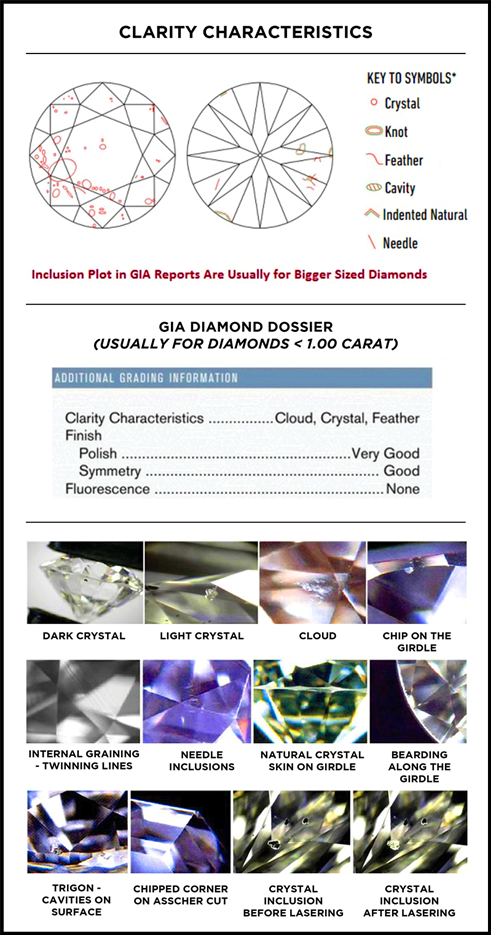
How to Rate Diamond Clarity
According to the Gemology Institute of America (GIA), Diamond Clarity has six different categories and 11 specific grades that will help you determine the clarity of your loose diamonds. The 11 categories are named and described below.
Flawless (FL): These diamonds are nearly impossible to find, and in fact, most jewelers and diamond buyers will spend a lifetime in the industry and never come across one. When a diamond is FL or Flawless, it has no inclusions and no blemishes visible under 10x magnification.
Internally Flawless (IF): This diamond is about as close to perfect as most people can find. When a diamond is IF, it means there are no inclusions visible under 10x magnification, although there may be some blemishes present at high magnification.
Very, Very Slightly Included (VVS1 and VVS2): When inclusions are so slight that a grader can barely see them under 10x magnification, they are given a VVS grading. A VVS1 is slightly better than a VVS2.
Very Slightly Included (VS1 and VS2): These inclusions can be seen very slightly under a 10x magnifier, but their impact and size are relatively minor. They are only barely visible under 10x magnification and are not visible to the naked eye. A VS1 has less visible inclusions or blemishes than a VS2.
Slightly Included (S1 and S2): These inclusions can be seen under 10x magnification, and they may be visible to the naked eye as well, depending on the type of blemish or inclusion. However, that doesn’t mean that the diamond can’t be beautiful. A common issue you will see in S1 and S2 diamonds is feathering which are breaks in the diamond.
Included (I1, I2, I3): With Included rankings, the inclusions in the diamond are very visible under 10x magnification. These types of inclusions may impact how transparent the diamond is and how brilliant it is or how much it shines. These are the lowest ranking of diamonds when it comes to clarity.
The thing to remember about the clarity of diamonds is that while differences may be very noticeable under 10x magnification, they are often barely noticeable to the naked eye. The average person may not notice the difference between a VS1 and an S1 without the help of a professional. That is why the diamond graders at our Quincy, MA shop.
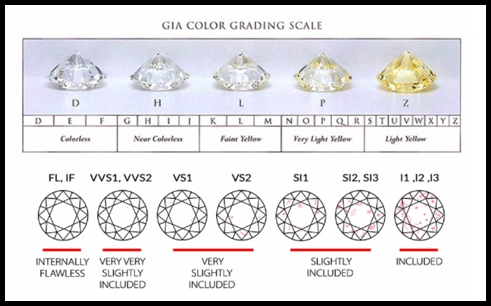
How much can I get for my diamond?
Diamond prices are determined by the carat weight, color, cut, shape, and the demand in the retail marketplace for the diamond. Better quality yields a higher price.
My engagement ring has two carats of total carat weight and I paid $7,500 for it. I want to get at least half of what I paid…
We always tell our customers to avoid buying diamonds based on carat total weight. Most customers do not think about the resale value upon making a purchase, and generally, there is a low resale value when you try to sell a carat total weight ring. These carat total weight items.
Pawn Your Diamonds at The Jewelers & Loan Co.
It’s no secret that diamonds have maintained their value for hundreds of years. There are few people on this planet that will turn their nose up at a diamond and as such, it has remained one of the most valued precious natural stones in the world. With that said, even the most beautiful diamond is wasted on someone without good use for it. If you are holding onto a diamond from a family heirloom, or you are finally ready to move on from an engagement or marriage, The Jewelers & Loan Co. is happy to buy your diamonds. All you have to do is come down to our local pawn shop and one of our buyers will be able to give you an appraisal value. The world’s most sought after diamonds can fetch for millions of dollars, but even every day diamonds can be worth thousands.
If you’ve been lucky enough to come across real diamonds in your life, you should know better than most that there is no denying the brilliance and beauty of these stones. Given to you by the right person—or the wrong person—a diamond says everything that can’t be put into words and it has the durability to say it forever.
Pawn Certified and Non-Certified Diamonds for Cash at our Local Pawn Shop
Whether you have a collection of loose diamonds, or you are finally ready to pawn an old diamond engagement ring, or other gifts from a previous relationship, walking into a diamond pawn shop can be uncomfortable and unfamiliar. At The Jewelers & Loan Co., we are happy to walk you through the diamond pawn process with confidence and dignity. We are proud to be a full-service diamond pawn shop.
The best place to start before you pawn your diamonds is with a solid foundation of diamond education. It’s important that you have a basic understanding of what impacts diamond value and what characteristics appraisals are looking for when they determine the value of the stone. Because diamonds are so luxurious and sought-after, the diamond industry can be overwhelming for people without the necessary experience.
Diamond Exchange for Cash
The truth is, there is a lot that goes into determining the value of a diamond. Even if you are not yet in the market to sell your diamond to a diamond pawn shop, it’s a good idea to have a baseline idea of your stone’s valuation. That way, if it ever comes time to sell or pawn your diamond ring, or upgrade to a different diamond, you aren’t caught off guard by the price. At The Jewelers & Loan Co., we seek to help all of our customers invest their money in diamonds that will have a high resale value if they ever decide to upgrade and we seek to get you the most fair and accurate price for your precious diamond gemstone. If you upgrade down the line, sell due to an emergency, or even pawn or borrow against your diamond, it’s important to purchase the diamond with the correct mix of attributes.
Pawn Your Diamond Rings
Before we dive into the specifics of diamond identification and valuation, there are a few key items to take into consideration. Many diamond retailers, like BlueNile and their private equity partners, have done a great job making information about diamonds readily available to consumers. Because diamonds are such a high ticket item, diamond pawns and purchases come with a certificate of authenticity. Known as a GIA Certificate, this documentation is provided by an accredited independent gemological laboratory. The GIA Certificate will provide details about the diamond’s carat weight and measurements as well as grading for the stone’s cut, color, and clarity. For most diamond retailers, The GIA Certificate is considered a reputable certification, but there is another kind of common certification from the European Gemological Laboratory (EGL). Unlike the GIA, the EGL is a for-profit institution and has a reputation for providing less rigorous testing and certification.
Many people will erroneously assume that just because a diamond has a certificate that it is a worthwhile investment. At The Jewelers & Loan Co., we recommend that you make all diamond purchases and sales based on the stone in front of you. Though diamonds are inherently valuable, all purchases and sales should be made with your unique preferences in mind. If you like the diamond, that is a step in the right direction towards gifting your loved one with a high-quality gift they’ll love for years.
At The Jewelers & Loan Co., we are committed to providing all of our customers with an experience that they can trust. We want our customers to be armed with the necessary tools and information to make the best decisions for themselves, but that doesn’t mean we intend to hang you out to dry. At The Jewelers & Loan Co., you can trust that we know what we are talking about and we will walk you through every step of the diamond pawn and buying process.
Types of Diamond Shapes and Cuts
All diamonds have their own unique beauty and characteristics, but that doesn’t mean all diamonds are the same. Diamonds can be cut into a variety of shapes including:
- Round
- Princess
- Marquise
- Emerald
- Oval
- Cushion
- Radiant
- Heart
- Pear
The shape that you’re attracted to is entirely up to you and it may change depending on trends and your lifestyle. Round diamonds are the most popular shape, and they generally have the highest resale value. The other shapes and colors, known as fancy shapes and colors, still hold great value, so it ultimately comes down to your unique taste preferences. Fancy shapes such as princess, cushion, marquise, heart and oval are particularly striking and their scarcity may also be reflected in their valuation.
Communities We Serve
We help residents in the Massachusetts communities sell, buy, and pawn their certified and non-certified diamonds, including Boston, South Shore, Quincy, Dorchester, Milton, Braintree, Hingham, Cohasset, Weymouth, Randolph, Holbrook, Rockland, Abington, Hanover, Norwell, Marshfield, Pembroke, Hanson, Whitman, Mattapan, Lower Mills, and elsewhere in Plymouth County.
In addition to pawning and selling diamonds, we have a full-service suite of offerings to help our customers get the most money for their items:
e Jewelers & Loan Co., you can trust that we know what we are talking about and we will walk you through every step of the diamond pawn and buying process.
- Cash for Gold
- Diamond Buyer
- Cash for Jewelry
- Cash for Silver
- Rolex Watch Buyer
- Pawn Jewelry
- Pawn Gold
- Pawn Silver
For more information about diamonds and how to pawn your diamonds at our shop, contact our team today!
